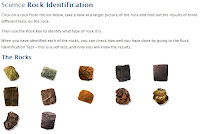Many National Qualifications require students to answer multiple choice questions, carry out simple recall eg colours, names, formula, write short three line explanations etc. Other country's National Qualifications such as NCEA (National Certificate of Educational Achievement), New Zealand's National Achievement Qualification requires a deeper level of thinking, it isn't better or worse than other National Qualifications, just different!
Students aren't required to write "big words" but have clear "big images" in their mind so that they can state, describe and explain scientific concepts in "big detail".
So, to help your students capture visual images of "big ideas", here's a few truly innovative, creative and collaborative suggestions...
Piclit creative writing by matching beautiful images with carefully selected key words
Tag Galaxy explores images in Flickr
simply enter a tag and explore an option that interests you via a virtual Galaxy of words
until you are transported to a globe where you view the relevant image(s) related to your original tag
Tagxedo turns words into a tag cloud
there are many, many ways to use this in a classroom, see 101 ways to use Tagxedo for some inspiration
wordle another means of generating word clouds
download this free program to create your own picture collages
Make a timeline using TimeRime
Glogster EDU for making interactive posters
How can students put these "big images" into "big detail"? The literacy suggestions outlined below work, and they work well. Students apply the technique of providing clear, detailed information on a scientific concept using a familar everyday activity of cleaning teeth.
Set the task: Provide all students with the State, Describe and Explain in detail guidelines. Ask students to write/type individually their ideas on...
How to clean teeth
State in one sentence eg. Put some toothpaste onto a toothpaste and use it to scrub your teeth.
Describe in three or four sentences eg. Place a pea sized amount of a toothpaste onto a manual or electric toothbrush. Rub the toothbrush sideways and up and down on all teeth. Rinse mouth out with tap water. Then, wrap a piece of dental floss around your index fingers and move the dental floss sideways between all teeth to remove any plaque. Rinse mouth out with tapwater.
Explain in detail by comparing and contrasting, relating to everyday life, link to scientific ideas. Students should write a detailed paragraph in which they compare and contrast eg a manual with an electric toothbrush, discuss the neutralising effect of toothpaste on acid in the mouth (pH < 7) after eating which should help prevent tooth decay, suggest using mouthwash etc...
Another topic that works quite well for introducing this literacy task is My favourite holiday destination.
For younger students I usually ask them to write a SEXY paragraph on a certain topic
The Task: Write a SEXY paragraph on Global Warming
S - statement Global Warming means an increase in the temperature of the Earth's atmosphere.
E - explanation Carbon dioxide gas traps heat energy which results in an increase in the temperature of the Earth's atmosphere. Ultra violet rays from the sun are highly penetrating and are able to pass through clouds of carbon dioxide, however, once they hit the surface of Earth they lose energy and become low energy infra red (or heat) and are unable to escape through the thick clouds of carbon dioxide.
X - example burning of fossil fuels contributes to an increase of carbon dioxide in the atmosphere
Y - consequence As a consequence of global warming the ice caps could melt at an increasing rate and result in the flooding of low lying areas and the sinking of some Polynesian islands. "A picture is worth a thousand words", in everyday life - yes, in examinations, unfortunately no!





















































